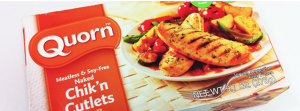
Did you or someone you know eat Quorn and get sick? Let us know!
File an adverse reaction report here.
Some people react the first time they eat Quorn, while some react only after building up a sensitivity. Two deaths have been linked to Quorn. The parents of an 11-year-old California boy sued the maker of Quorn in March 2015.

Medical studies have proven that Quorn's fungal ingredient is an allergen, but the U.S. Food and Drug Administration and the United Kingdom's Food Standards Agency still allow its sale. All of us at CSPI have heard from more than 2,000 consumers in Europe, the United States, and Australia/New Zealand who suffered reactions to Quorn.
Despite what some of the manufacturer's marketing materials indicated, the fungus used in Quorn is only distantly related to mushrooms, truffles, or morels. While all are members of the fungus kingdom, Quorn is made from a less appetizing fungus (or mold) called Fusarium venenatum (venenatum is the Latin word for venomous).
Medical Evidence Shows that Quorn Causes Adverse Reactions
The first evidence that Quorn causes severe vomiting and stomach ache came in 1977 from a clinical study conducted by the developer of Quorn. That research was never published. In subsequent years, more research has demonstrated that Quorn causes gastrointestinal and other adverse reactions, including hives and breathing difficulties. These are the key studies:
RHM (unpublished 1977-78 study)
This controlled clinical study was conducted by the company that developed Quorn. Ten percent of the 200 subjects who ate Quorn experienced nausea, vomiting, or stomach ache, compared to five percent of 100 subjects in a control group. This is the first known study that demonstrated that Quorn could cause adverse effects. It appears that when Marlow Foods notified the Food and Drug Administration that Quorn should be considered "Generally Recognized As Safe," it did not acknowledge the existence or results of this study. It is not known whether the study was submitted to the British government when Quorn was first used. The study was obtained from a food additive petition filed with the FDA.
Udall JN, Lo CW, Young VR, Scrimshaw NS. (Am J Clin Nutr. 1984;40:285-292)
This study did not find any problem in 100 college students who ate Quorn for 30 days. However, co-author Nevin Scrimshaw in 2003 told the U.S. Food and Drug Administration that "I have no doubt from the evidence currently available that the fungal product being marketed as Quorn, and that is causing an alarmingly high frequency of allergic reactions, some of them quite serious, is not the same product we tested. He added: "I am appalled that this material is allowed to stay on the market."
Tee RD et al. (Clin Exper Allergy. 1993;23:257-260)
This study was the first to appear in the medical literature and indicated possible safety problems with Quorn. The study involved 10 Britons who believed that Quorn caused vomiting or stomach ache. The study used classic allergy tests (like the skin-prick test) to assess the patients. There were weak indications that Quorn was allergenic, but the test methods used are considered insensitive and not highly accurate. The subjects were not fed Quorn foods, which might have elicited adverse reactions.
Katona SJ, Kaminski ER. (J Clin Pathol. 2002 Nov;55(11):876-877)
This letter from British researchers reported sensitivity to Quorn in a mold-allergic patient.
Hoff M et al. (J Allergy Clin Immunol. 2003 May;111(5):1106-1110)
These European researchers proved that Quorn caused an asthmatic reaction in a patient. They identified the particular protein that caused the allergic reaction. This paper is important.
Jacobson, MF. (Allergy. 2003 May;58(5):455-456)
This letter, submitted by the then executive director of the Center for Science in the Public Interest, described the adverse reactions reported by the first 284 people who contacted CSPI. It was the first item in the medical literature that indicated that Quorn caused widespread reactions, including vomiting, stomach ache, hives, and breathing difficulties.
Van Durme P, Ceuppens JL, Cadot P. (J Allergy Clin Immunol. 2003 Aug;112(2): 452-454)
Belgian researchers identified a young woman who suffered a severe anaphylactic-type allergic reaction after her first ingestion of Quorn. Skin prick tests were highly positive with Quorn extracts. The researchers deduced that Quorn can be cross-reactive with inhaled mold spores.
Jacobson, MF. (Am J Med 2003 Sep;115:334)
This letter, submitted by the then executive director of the Center for Science in the Public Interest, described the adverse reactions received by CSPI. The letter cites a survey suggesting that mycoprotein is more likely to cause adverse reactions than shellfish, milk, peanuts, and other common food allergens.
Sandhu M. (AllergyCases.org)
This case report describes a 14-year-old boy who had a reaction within two minutes of eating Quorn imitation chicken. The symptoms included throat irritation followed by itchiness, difficulty breathing, and swelling of the lip, tongue, eye, and laryngeal edema. A positive skin test demonstrated a sensitivity to small amounts of Quorn (and other molds).
Jacobson, MF, DePorter J. (Ann Allergy Asthma Immunol. 2018 Mar;120:626-630)
This article analyzes 1,752 self-reports of adverse reactions to Quorn reported to the Center for Science in the Public Interest. Allergic reactions, including hives and anaphylaxis, occurred within 4 hours of consumption in 312 people, and gastrointestinal symptoms, including vomiting and diarrhea, occurred within 8 hours of consumption in 1,692 people.

